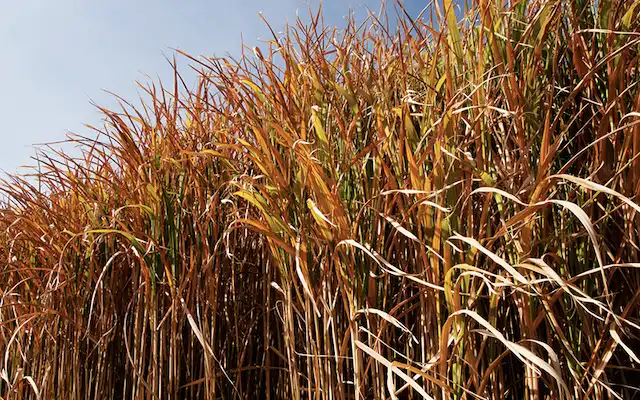“Have you ever wondered about life on a leaf?”
Great Lakes Bioenergy Research Center (GLBRC) researcher Ashley Shade asks a simple question, but it’s one well worth investigation. The aboveground part of plants where microbes reside, or the phyllosphere, represents the largest environmental surface area on the plant. Much of this area is grown as cultivated agriculture, and understanding the interactions between plants and the microorganisms that live on their surfaces may help us develop agricultural management practices that can increase crop productivity and resilience. In their newly published study, Department of Energy Bioenergy Research Center collaborators at GLBRC and the Center for Advanced Bioenergy and Bioproducts Innovation (CABBI) peer into the complexities of life on a leaf.
Perennial plants like switchgrass and miscanthus are a crucial target for the sustainable development of biofuels. In addition to yielding large amounts of biomass that can be converted into biofuels and bioproducts, perennial crops offer a broad range of ecosystem services that support efforts to mitigate climate change, such as sequestering greenhouse gases and driving nutrient cycling in the soil.
Like all plants, perennials are home to a wide variety of microbes, and many of these microbes benefit their hosts. For example, some plant-associated microbes can increase the plant’s productivity and offer some protection against environmental stressors like heat and drought. Because of this, management of the plant microbiome is one tool proposed to promote crop growth and resilience, which is particularly important in the face of global climate change. Along with selective breeding and data-informed field practices, microbiome management is expected to be instrumental in the sustainable production of biofuel feedstocks.
Different parts of a plant are home to different microbes. Many researchers in recent years have studied the plant-microbe interactions that take place in the rhizosphere — the belowground area around the roots — which play a key role in a plant’s ability to uptake water and nutrients. However, the aboveground phyllosphere, which includes the surfaces of leaves, is also home to some very important microorganisms. Namely, phyllosphere microbes are known to play roles in carbon cycling and protecting plants from harmful pathogens. Because perennial biofuel feedstocks like miscanthus and switchgrass are often selected to maximize leaf surface area, understanding the phyllosphere microbiome and the plant-microbe interactions that take place there is expected to play a very significant role in our ability to improve feedstock production.
In the newly published study, “Seasonal Activities of the Phyllosphere Microbiome of Perennial Crops,” researchers used cutting-edge gene sequencing and bioinformatic tools to identify what microbes live and grow on the leaves of bioenergy crops, and how these microbes respond to plants throughout the growing season.
The study, published in Nature Communications, was led by CABBI Sustainability Theme researcher Adina Howe, an Iowa State University Associate Professor of Agricultural and Biosystems Engineering; and GLBRC’s Shade, a Michigan State University Associate Professor of Plant, Soil, and Microbial Sciences.
“Miscanthus and switchgrass are known to share common phyllosphere microbes,” Howe said. “In this study, we show when they’re actively growing and identify what they are doing. Living on the leaf, these microbes can biosynthesize natural products that may be important for responding to plant stressors.”
To study the leaf microbiomes and their dynamics throughout the growing season, the researchers collected switchgrass and miscanthus leaf microbiomes monthly from May to November.
From these samples, the research team sequenced the microbiomes’ metagenomes and metatranscriptomes. A metagenome is a collection of all the genes that can be found among individuals in a group (i.e., the pool of genes that could potentially be expressed), while a metatranscriptome specifically refers to the genes that are actively being expressed by individuals in a group. Using bioinformatic tools, the microbiomes’ metagenomes and metatranscriptomes were analyzed, revealing the types of microbes present in the phyllosphere and their gene expression throughout the growing season.
This study indicates that leaf microbes are actively growing and expressing genes that produce various metabolites. For example, genes associated with terpene production were frequently expressed in the phyllosphere. Terpenes are interesting because they are used as signaling molecules in plants and bacteria and can help protect plants from stress. Terpenes are also involved in the regulation of production of nitric oxides and methane, which are powerful greenhouse gases. This study also found that different groups of microbes varied in abundance and metabolic function over the growing season, suggesting that they may be responding to different plant cues.
Overall, this research points to specific microbial functions that could be targeted for future plant-microbe management, which could be used to promote crop growth and resilience.
Though small, life on a leaf might just be one of the keys to a more sustainable future.
Co-authors on this study include GLBRC team members and collaborators Nejc Stopnisek, Shane Dooley, Fan Yang, and Keara Grady.
Read the paper: Nature Communications
Article source: Great Lakes Bioenergy Research Center (GLBRC)
Author: April Wendling, CABBI Communications Specialist
Image: Miscanthus is a promising target crop for bioenergy production, but its great size also offers a wealth of aboveground surface area for microbes to thrive. Credit: GLBRC






